The Effect of Covid-19 on the Use of Medicinal and Aromatic Plants: The Case of Turkey
IF 0.7
4区 生物学
Q3 PLANT SCIENCES
引用次数: 0
Abstract
Covid-19, one of the coronaviruses has emerged in Wuhan, China as a result of zoonotic infection towards the end of December 2019. According to WHO data, Covid-19 has been present among approximately 221 million people in 222 countries, causing death for 4.5 million. Furthermore, these figures are increasing every day. In Turkey, approximately 6.5 million people have been infected thus far, and 58,651 of them lost their lives. People have preferred medicinal and aromatic plants to protect/treat themselves from Covid-19. The following questions were investigated in this study: Does Covid-19 affect the use of medicinal and aromatic plants? If it does, what are the changes? What types of herbs are used and in which ways they are used? Who advises people to use these herbs? According to the results, 113 taxa belonging to 61 families and 105 genera were used by the participants at the genus, species and subspecies level. Herbs that were widely used are Thymus sp., Tilia sp., Salvia officinalis L., Zingiber officinale Roscoe, Mentha piperita L., Curcuma longa L., Rosa canina L., Camellia sinensis (L.) Kuntze, Lavandula officinalis Chais, Matricaria sp., respectively. There was a positive and moderate-level relationship between the use of medicinal and aromatic plants before and after COVID-19, and another positive and moderate-level relationship between the frequencies of using medicinal and aromatic plants before and after the pandemic. The relationships were significant for both questionnaire items. Moreover, there was a significant difference between the frequency of use regarding medicinal and aromatic plants before and after Covid-19.新冠肺炎对药用和芳香植物使用的影响:以土耳其为例
新冠肺炎是2019年12月底在中国武汉出现的一种冠状病毒,是人畜共患传染病的结果。根据世界卫生组织的数据,新冠肺炎已在222个国家的约2.21亿人中出现,导致450万人死亡。此外,这些数字每天都在增加。到目前为止,土耳其约有650万人感染,其中58651人丧生。人们更喜欢药用和芳香植物来保护/治疗自己免受新冠肺炎的感染。本研究调查了以下问题:新冠肺炎是否影响药用和芳香植物的使用?如果是,会有什么变化?使用了哪些类型的草药以及它们的使用方式?谁建议人们使用这些草药?根据结果,参与者在属、种和亚种水平上使用了隶属于61科105属的113个分类群。被广泛使用的草药分别是Thymus sp.、Tilia sp.、Salvia officinalis L.、Zingiber officinale Roscoe、Mentha piperita L.、Curcuma longa L.、Rosa canina L.、Camellia sinensis(L.)Kuntze、Lavandula officinals Chais、Matricaria sp。新冠肺炎前后药用和芳香植物的使用之间存在正的和中等水平的关系,而在大流行前后药用和芳族植物的使用频率之间存在另一种正的和中度的关系。两个问卷项目之间的关系都很显著。此外,新冠肺炎前后药用和芳香植物的使用频率存在显著差异。
本文章由计算机程序翻译,如有差异,请以英文原文为准。
求助全文
约1分钟内获得全文
求助全文
来源期刊

Mediterranean Botany
Agricultural and Biological Sciences-Plant Science
CiteScore
2.40
自引率
10.00%
发文量
30
审稿时长
12 weeks
期刊介绍:
Mediterranean Botany (ISSNe 2603-9109), formerly Lazaroa, is a biannual journal that publishes original research studies in the field of Botany including plant systematics, vegetation ecology, biogeography, evolutionary biology, ecophysiology, community ecology, ethnobotany and conservation biology on Mediterranean biomes but also in interacting areas.
Mediterranean Botany is an OPEN ACCESS Journal, free of charges for any published article.
 求助内容:
求助内容: 应助结果提醒方式:
应助结果提醒方式:


